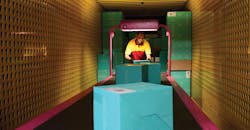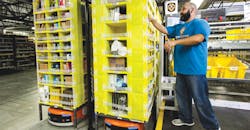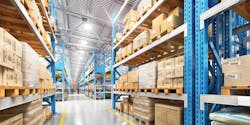E-commerce transforms trucking equipment, labor and logistics
Trucking continues to adapt to U.S. consumers’ desire to buy more goods online and have more control over when — and where — those goods are delivered. Just 20 years ago, less than 1% of U.S. retail sales were made online; by 2017, that number grew by 3,000% to more than 9% of all U.S. retail sales.
The growing number of deliveries to individual residences is changing the vehicles being used by fleets, according to Rick Blasgen, executive director of the Council of Supply Chain Management Professionals (CSCMP).
Andy Moses, senior vice president of global products for Penske Logistics said the type of equipment Penske has invested in runs the gamut.
“If you’re in that so-called ‘final-mile’ phase, you might want smaller, more nimble vehicles. There are intermediary steps where products are moving into and out of distribution centers that may rely on traditional tractors and trailers,” he said.
Seko Logistics’ fleet of final-mile trucks consists mostly of box trucks, delivery vans, and hybrids. Brian Bourke, vice president of marketing for Seko, noted the company is still adding additional assets. “That isn’t going to slow down,” he said.
FedEx continues to experience growth in demand for large, heavy package deliveries, especially during the holiday peak season, said Jonathan Lyons, a spokesman for FedEx. As a result, FedEx has engineered its networks to add sortation and delivery capabilities for these packages, including facilities dedicated to non-conveyable items.
Jeff Abeson, vice president of business development, supply chain solutions and dedicated transportation for Ryder, said the delivery experience related to large consumer packages and home deliveries has to be consistent.
Ryder receives delivery requests through the retailer and schedules deliveries directly with the customer.
“It is 100% self-service. You’re given the option to pick your date. If you change your mind, you can go back and change it,” Abeson explained.
The backside of the technology gives Ryder the ability to watch drivers via a smartphone app.
“Our people are watching and if something goes wrong, exception management kicks in,” Abeson said. “More often than not, if we properly communicate with the consumer, that solves a lot of problems that occur in the industry.”
Finding labor
Within e-commerce, labor demands are high when considering the number of associates needed to make the process seamless for the end user.
“This past year we’ve probably been operating in the lowest unemployment environment I can remember in this country. It has been particularly challenging this past year on the whole staffing side of it,” Penske’s Moses said.
David Caines, chief operating officer of Kenco, said the worker shortage increases the need to automate roles to ensure proper load tracking and scheduling. Linking inventory flows with information on hours of service and driver availability enables providers to adjust faster, said Scott Pruneau, CEO of ITS Logistics. He added ITS is utilizing a capacity aggregation strategy “where we’re employing as many drivers as we can based on the schedules we have.”
Bourke said Seko Logistics has become more consumer-focused, which changes how the company recruits drivers.
“Being selective in the hiring of drivers and looking at that customer service experience is important because these items are going into consumers’ homes,” he explained. “That wasn’t as important in the past as it is now.”
The last mile
In addition to helping with scheduling, visibility can also increase customer satisfaction. Bourke said it is essential for logistics providers to define what visibility means to the consumer.
“It used to be a tracking number, but that, increasingly, is not enough,” he said. “The expectations for visibility are constantly being raised because of the advent of the smartphone and other companies that have leveraged the smartphone.”
Logistics providers are working to make the final delivery as convenient as possible for consumers. However, the last mile is the toughest part of the e-commerce supply chain, said Lee Spratt, CEO of DHL eCommerce Americas.
“It plays a significant role in the customer experience, and with cities becoming increasingly congested and urban consumers requiring more convenience, there is huge pressure on retailers to be ever more flexible while keeping their costs down over the final mile,” he explained.
Eddie Adkins, director of distribution and fulfillment for Averitt Express, said the experience of the final-mile delivery is vital for shippers and the standing of their business. “New shipping and tracking technologies remove the guessing of when a customer will receive their shipment,” he said.
DHL introduced the flexible transport networks, automation and data model at the end of 2018 as a way to help e-commerce merchants and their logistics partners better understand how to improve their performance and compete over the last mile, particularly in urban environments.
“There isn’t a one-size-fits-all solution that will allow companies to increase their competitiveness,” Spratt said.
He added that DHL is piloting flexible delivery models, such as the DHL Parcel Metro service of DHL eCommerce, increasing the levels of automation in its distribution and fulfillment centers through robotics and automated conveyors, and employing an increasing number of data scientists that will build up its capabilities in machine learning, data analysis, and management.
FedEx offers the FedEx Delivery Manager mobile app to help customers coordinate deliveries, especially during the busy holiday season. “Customers can choose where a package is delivered and when and redirect it to one of more than 1,900 FedEx Office retail stores, a FedEx OnSite location or other FedEx hold locations, or even leave instructions for the courier,” Lyons said.
International Shipments
In terms of time and speed, international supply chains have many different moving parts.
“When these parts are not in sync, which is often a result of using multiple service providers that handle individual portions of the supply chain, delays are inevitable,” Adkins said. “Communication between each link in the supply chain is a key factor that will either slow down or speed up the process.”
Averitt Express has a complete end-to-end supply chain service for international e-commerce shippers that is managed under one roof. “We handle the customs brokerage, supplier communications, ocean forwarding, inland transportation, inventory management, and order fulfillment,” Adkins continued.
Leveraging network
Logistics providers said an advantage they offer is the ability to leverage their technology investments across multiple clients. They can also leverage their network to meet retailers’ reverse logistics needs.
Kenco’s Caines said third-party logistics (3PL) providers can analyze retailers’ supply chains with an eye on the post-purchase process, helping organizations design the right networks for returns.
“3PL partners also examine why returns are happening on the front-end and review the history of returns by volume and profile to provide companies with data on what products or time periods are overloading the reverse network,” he said.
* * *



